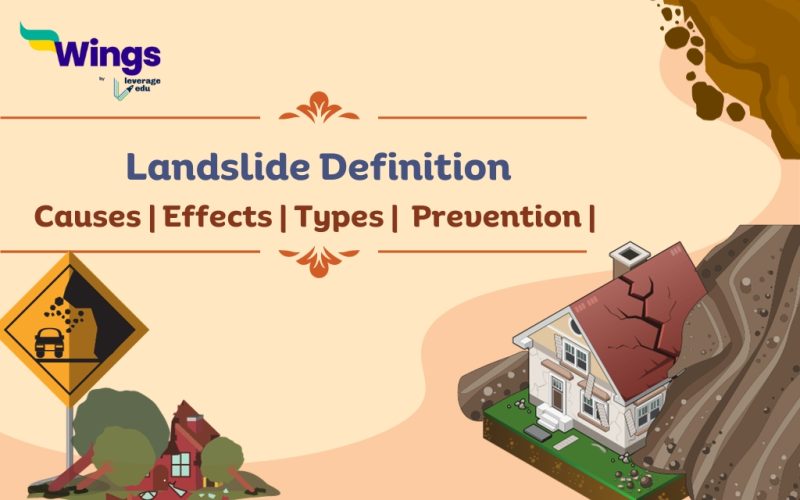Landslides, also known as landslips, are the most destructive type of natural phenomenon that causes significant damage to human life and property. In simple words, landside refers to the massive movement of rock, debris, soil, or earth in a downward slop-like movement. This is because gravity is the primary driving force. Moreover, they can occur anywhere in the world but are specifically more common in mountain regions that have steep slopes. Now that we know about the landslide definition, let us explore the causes, effects, types, and prevention of landslides,
Causes of Landslide
After the landslide definition comes its primary causes. Landslides generally occur when the slope undergoes some processes that change its overall condition and make it unstable. It can also occur when any type of shear stress exceeds the sheer strength of or the resistance strength of the materials that join to form the slope.
Natural causes of landslides include:
- Increase in water content due to snow or glacier melting
- The rising of groundwater due to rainwater infiltration
- Loss of soil structure or nutrients due to wildfire
- Erosion due to water bodies
- Physical or chemical weathering
- Earthquakes
- Volcanic eruptions

Human activities that cause landslides include:
- Deforestation
- Over cultivation of land
- Heavy and consistent construction
- Blasting and mining activities

Also Read: What is a Natural Disaster? Types, Causes, Events
Effects of Landslide
The aftermath of a landslide can be extensive and unimaginable.
- Landslides can lead to the loss of human lives.
- It can cause destruction to the infrastructure of the affected regions.
- Landslide disasters can also damage natural resources.
- It can also block water bodies which further increases the risk of flooding.
- Farmers can lose their crops and livestock which can deteriorate their living conditions.
- It can also cause roadblocks and make transportation impractical.
Types of Landslide
Interestingly, landslides are classified based on the type of movement they show. Generally, there are four types of movements such as falls, slides, topples, and flows. Let’s explore them in more detail.
Falls
- Falls are sudden movements or landslides that include the breaking away of soil, debris, and rock from slopes and cliffs.
- Characteristics of fall landslides include contents free falling from height through the air and bouncing and rolling over.
Slides
- As the name suggests, slides include the material slipping or dropping along a rupture or slip surface.
- The top of this type of landslide has a scarp which is a steep drop as well as a flat portion behind it which is called the bench.
- Slide-type landslides are of two types, rotational slides (slumps) and translational (planar) slides.
Also Read: What is Soil Erosion? Definition, Causes, Effects and Prevention
Topples
- Topples are a bit different from other types of landslides.
- They include a mass of rock or debris falling in the forward direction out of a slope.
- They are more common at the bottom of the block of the rock.
- Ice melt and weathering can cause topple landslides.
Flows
- As the name implies, flow-type landslides include the mass movement of debris, soil, and rocks from a slop in the form of a fluid.
- Flow landslides leave behind an upside-down funnel-shaped deposit. This place signifies where the material has stopped flowing.
- It can include mud, debris, and rock avalanche flows.
Also Read: What are 10 Ways to Reduce Pollution?
Prevention of Landslide Tips
The concept of prevention is better than cure goes for various aspects of our lives. For instance, although one cannot truly avoid landslides completely forever, numerous ways can mitigate their effects and help to reduce the frequency. Here is what the prevention of landslides includes:
- Steps can be taken to identify landslide-prone areas and ask the residents to vacate the area during monsoons.
- Monitoring and warning systems can be made better.
- The government can impose restrictions on heavy construction activities.
- Deforestation should be avoided and awareness should be spread about the need for afforestation.
- Water drainage systems and management should be improved.
- Evacuation plans should be made in advance to deal with unforeseen situations.
Also Read: Essay on Save Trees: Trees for Generation
Related Blogs
| National Pollution Control Day 2023 | Slogans on World Environment Day |
| Water Pollution Definition | Types of Pollution |
| What is the Causative Germ for AIDS? | Take the World AIDS Day Quiz! |
FAQs
To explain the landslide definition in a few words, landslides are nothing but a large mass of soil, rocks, mud, and land that slide from the earth’s surface in a downward direction. This happens when external or internal shear stress somehow exceeds the resistance strength of the slope.
Landslides are of different types and can occur due to a wide range of reasons such as deforestation, earthquakes, an increase in water concentration, etc. Moreover, this sudden movement of massive earth, rocks, mud, and debris can cause major damage to human life, infrastructure, property, and more.
The four types of landslides include falls, topples, slides, and flows.
Hope you have fun learning this informative content on landslide definition, causes, types, effects, and prevention. For more information about such informative articles, check the trending events page of Leverage Edu.
 One app for all your study abroad needs
One app for all your study abroad needs













